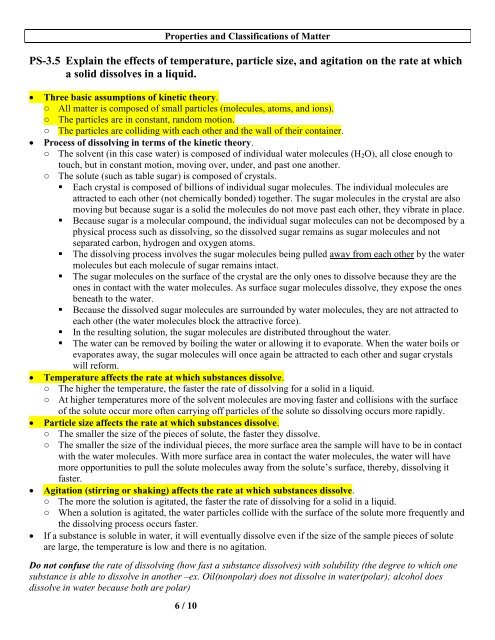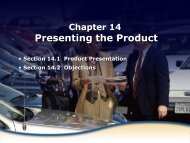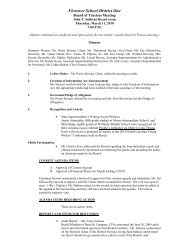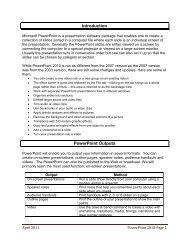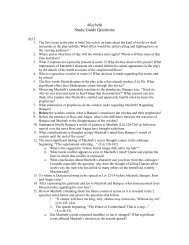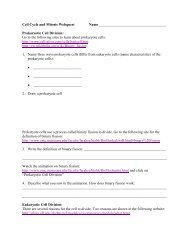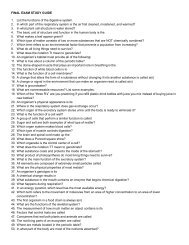PS-3.1 Distinguish chemical properties of matter (including reactivity ...
PS-3.1 Distinguish chemical properties of matter (including reactivity ...
PS-3.1 Distinguish chemical properties of matter (including reactivity ...
Create successful ePaper yourself
Turn your PDF publications into a flip-book with our unique Google optimized e-Paper software.
Properties and Classifications <strong>of</strong> Matter<strong>PS</strong>-3.5 Explain the effects <strong>of</strong> temperature, particle size, and agitation on the rate at whicha solid dissolves in a liquid.Three basic assumptions <strong>of</strong> kinetic theory.○ All <strong>matter</strong> is composed <strong>of</strong> small particles (molecules, atoms, and ions).○ The particles are in constant, random motion.○ The particles are colliding with each other and the wall <strong>of</strong> their container.Process <strong>of</strong> dissolving in terms <strong>of</strong> the kinetic theory.○ The solvent (in this case water) is composed <strong>of</strong> individual water molecules (H 2 O), all close enough totouch, but in constant motion, moving over, under, and past one another.○ The solute (such as table sugar) is composed <strong>of</strong> crystals.• Each crystal is composed <strong>of</strong> billions <strong>of</strong> individual sugar molecules. The individual molecules areattracted to each other (not <strong>chemical</strong>ly bonded) together. The sugar molecules in the crystal are alsomoving but because sugar is a solid the molecules do not move past each other, they vibrate in place.• Because sugar is a molecular compound, the individual sugar molecules can not be decomposed by aphysical process such as dissolving, so the dissolved sugar remains as sugar molecules and notseparated carbon, hydrogen and oxygen atoms.• The dissolving process involves the sugar molecules being pulled away from each other by the watermolecules but each molecule <strong>of</strong> sugar remains intact.• The sugar molecules on the surface <strong>of</strong> the crystal are the only ones to dissolve because they are theones in contact with the water molecules. As surface sugar molecules dissolve, they expose the onesbeneath to the water.• Because the dissolved sugar molecules are surrounded by water molecules, they are not attracted toeach other (the water molecules block the attractive force).• In the resulting solution, the sugar molecules are distributed throughout the water.• The water can be removed by boiling the water or allowing it to evaporate. When the water boils orevaporates away, the sugar molecules will once again be attracted to each other and sugar crystalswill reform.Temperature affects the rate at which substances dissolve.○ The higher the temperature, the faster the rate <strong>of</strong> dissolving for a solid in a liquid.○ At higher temperatures more <strong>of</strong> the solvent molecules are moving faster and collisions with the surface<strong>of</strong> the solute occur more <strong>of</strong>ten carrying <strong>of</strong>f particles <strong>of</strong> the solute so dissolving occurs more rapidly.Particle size affects the rate at which substances dissolve.○ The smaller the size <strong>of</strong> the pieces <strong>of</strong> solute, the faster they dissolve.○ The smaller the size <strong>of</strong> the individual pieces, the more surface area the sample will have to be in contactwith the water molecules. With more surface area in contact the water molecules, the water will havemore opportunities to pull the solute molecules away from the solute’s surface, thereby, dissolving itfaster.Agitation (stirring or shaking) affects the rate at which substances dissolve.○ The more the solution is agitated, the faster the rate <strong>of</strong> dissolving for a solid in a liquid.○ When a solution is agitated, the water particles collide with the surface <strong>of</strong> the solute more frequently andthe dissolving process occurs faster.If a substance is soluble in water, it will eventually dissolve even if the size <strong>of</strong> the sample pieces <strong>of</strong> soluteare large, the temperature is low and there is no agitation.Do not confuse the rate <strong>of</strong> dissolving (how fast a substance dissolves) with solubility (the degree to which onesubstance is able to dissolve in another –ex. Oil(nonpolar) does not dissolve in water(polar); alcohol doesdissolve in water because both are polar)6 / 10


